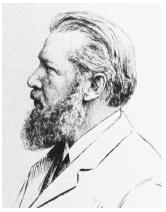Friedrich Wilhelm Ostwald
COFOUNDER OF MODERN PHYSICAL CHEMISTRY
1853–1932
Friedrich Wilhelm Ostwald, born in Riga, Latvia, Russia, almost single-handedly established physical chemistry as an acknowledged academic discipline. In 1909 he was awarded the Nobel Prize in chemistry for his work on catalysis , chemical equilibria, and reaction velocities.

Ostwald graduated with a degree in chemistry from the University of Dorpat (now Tartu, Estonia) and was appointed professor of chemistry at Riga in 1881, before he moved from Russia to Germany to become chair of the physical chemistry department at the University of Leipzig in 1887. For about twenty years he made Leipzig an international center of physical chemistry: by establishing an instruction and research laboratory that attracted virtually the entire next generation of physical chemists; by editing the first journal in the field ( Zeitschrift für physikalische Chemie ); and by writing numerous textbooks. In 1906 he retired from the university and devoted the rest of his life to various topics, including the history and philosophy of science, color theory, painting, the writing of textbooks and popular books about science, the international organization of science, and the formation of an artificial language for the international exchange of ideas.
Throughout his career as a chemist Ostwald followed the general approach of applying physical measurements and mathematical reasoning to chemical issues. One of his major research topics was the chemical affinities of acids and bases. To that end, he studied the points of equilibria in reaction systems where two acids in an aqueous solution compete with each other for a reaction with one base and vice versa. Because chemical analysis would have changed the equilibria, he skillfully adapted the measurement of physical properties, such as volume, refractive index, and electrical conductivity, to that problem. From his extensive data he derived for each acid and base a characteristic affinity coefficient independent of the particular acid–base reactions.
To understand different chemical affinities, Ostwald drew on a new, but then hardly accepted and not yet fully developed, theory advanced by the Swedish physical chemist Svante Arrhenius. According to this theory of electrolytic dissociation, electrolytes such as acids, bases, and salts dissociated in solution into oppositely charged ions to a certain degree, such that at infinite dilution dissociation was complete. Ostwald recognized that if all acids contained the same active ion, their specific chemical affinities must correspond to the number of these active ions in solution, which depended on their specific degree of dissociation at each concentration, and which could be measured through electric conductivity studies. By applying the law of mass action to the dissociation reaction, a simple mathematical relation was derived between the degree of dissociation α , the concentration of the acid c , and an equilibrium constant specific for each acid K :
This is Ostwald's famous dilution law from 1888, which he proved by measuring the electric conductivities of more than 200 organic acids at various concentrations. He substantiated the dissociation theory not only to explain the different activity of acids, but also as a general theory of electrolytes in solution. The theory gained further support from the Dutch physical chemist Jacobus Hendricus van't Hoff who, at the same time, advanced it on a general thermodynamic basis to explain his law of osmotic pressure of solutions as well as Raoult's laws of vapor pressure lowering and freezing point depression. Thus, the new physical chemistry grew to a comprehensive theory of solutions, based on both thermodynamics and dissociation theory.
Ostwald was particularly successful in systematizing and propagating these new ideas, applying them to other fields, and organizing a school of physical chemistry. Many chemists rejected the dissociation theory because it predicted wrong values at high concentrations and for strong electrolytes. Despite his concessions about its restricted validity, Ostwald provided numerous proofs of its broad usefulness in his textbooks on general, inorganic, and, particularly, analytical chemistry.
Originally, and incorrectly, Ostwald studied reaction velocities as a measure of chemical affinity. Later, he broadly investigated the time (or kinetic) aspects of chemical reactions and provided a system for the study of chemical kinetics. He first recognized catalysis as the change of reaction velocity by a foreign compound, which allowed him to measure catalytic activities. He distinguished catalysis from triggering and from autocatalysis, which he considered essential to biological systems. His most famous contribution to applied chemistry was on the catalytic oxidation of ammonia to nitric acid, which became widely used in the industrial production of fertilizers.
SEE ALSO Acid-Base Chemistry ; Arrhenius, Svante ; Equilibrium ; Physical Chemistry ; VAN'T Hoff, JACOBUS .
Joachim Schummer
Bibliography
Hiebert, Erwin N., and Körber, Hans-Günther (1978). "Ostwald, Friedrich Wilhelm." In Dictionary of Scientific Biography, Vol. XV, Supplement I, ed. Charles C. Gillispie. New York: Scribners.
Ostwald, Wilhelm (1926–1927). Lebenslinien: eine Selbstbiographie. 3 vols. Berlin: Klasing.
Rodnyj, N. I., and Solowjew, Ju. I. (1977). Wilhelm Ostwald. Leipzig: Teubner. (Russian original: Vilgelm Ostvald. Moscow: Nauka, 1969.)
Servos, John W. (1990). Physical Chemistry from Ostwald to Pauling: The Making of a Science in America. Princeton, NJ: Princeton University Press.
Comment about this article, ask questions, or add new information about this topic: